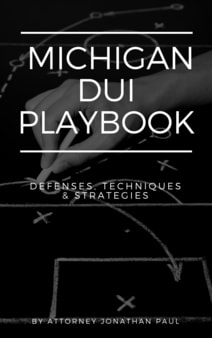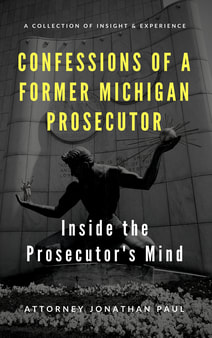As a former prosecutor I used to think field sobriety tests were a golden ticket to conviction. Along with the chemical tests, I had my police officer administering a number of super reliable tests and the results were typically favorable to prosecution. I would look at the police room and boom, boom, boom, I had the defendant sinking his/her own case. It wasn't until a few skilled defense lawyers began taking apart these tests that I soon realized they were not as reliable as I once thought.
In Michigan a witness, typically a police officer is allowed to testify to Standardized Field Sobriety Tests (SFST) results and how they relate to impairment if the witness is qualified by knowledge, skill, experience, training, or education. The law specifically states that the Horizontal Gaze Nystagmus (HGN) is admissible under this provision by an officer trained in how to perform the test.
In Michigan “Standardized Field Sobriety Test” means one of the standardized tests validated by the National Highway Traffic Safety Administration (NHTSA). A field sobriety test is considered a SFST under this section if it is administered in substantial compliance with the standards prescribed by NHTSA.
In simple terms if the police officer is qualified and follows the rules then the evidence can be introduced to the trier of fact or at a evidence hearing. The problem for many people charged is their attorney simply reads the police report and doesn't look into if these tests were done correctly. A cop is NOT going to say they did them wrong in the report - it takes watching the video and listening to the instructions to confirm compliance.
Based on my experience as a prosecutor, I know that the prosecutor has not watched the video or firmed up these tests; they just assume they are done correctly. This means if I look further into the issue and spot problems, they WILL NOT be prepared to respond at a hearing or trial, and I have a good shot at making a statement in front of a jury or judge and hopefully discredit these tests.
According to a State of Michigan law enforcement memo, the SFSTs are designed as divided attention or psychophysical tests which involve requiring the subject to concentrate on both mental and physical tasks at the same time.
These tests are designed to mimic the different abilities and tasks involved in operating a motor vehicle. These include information processing, short-term memory, judgment and decision making, balance, steady and sure reactions, clear vision, small muscle control and coordination of limbs.
As a criminal attorney, I am only looking for the BIG THREE: HGN, Walk & Turn and One Leg Stand, because any other test is not standardized and a fiction of the officer's imagination. An officer can just as easily as my client to recite the Detroit Tigers lineup as he can the alphabet - I am going to discredit anything outside of the BIG THREE right away.
According to various studies, the HGN is only 77 percent accurate, the Walk and Turn is 68 percent accurate and the One Leg Stand is only 65 percent accurate.
As a prosecutor, I would quickly glance at the officer's narrative and just assume "LOOKS GOOD" and move on. As a criminal defense lawyer, I dig into the details and test the officer narrative to the video/audio. Even a small difference between report and video could mean putting the officer in a position of trying to make his report/narrative more favorable and really discredit the whole process. We get the benefit of the doubt on the things we can't see and hear if what we can see and hear is not 100 percent accurate, and it's so important to make a big stink about it, because a jury doesn't know any better.
The first test is always the most fishy - the HGN, because there is no video or audio of what the officer is actually observing on my client since it's his eyes - I am looking for proper or improper instructions and if I can see how the officer is actually administering the tests. If he does it by the book, I am hoping that his credibility is put into question on another test, which I can see better such as the one leg stand or walk & turn, so I can argue that it simply taints all the tests.
According to the officer training manual here are the proper instructions:
1)Please remove your glasses (if worn).
2)Put your feet together, hands at your side. Keep your head still and follow this stimulus with your eyes only. 3)Keep looking at the stimulus until the test is over.
4)Do not move your head.
5)Do you understand the instructions?
The officer will then position the stimulus 12-15 inches from the suspect’s nose and slightly above eye level. He or she will first check to see if both pupils are equal in size (if they aren’t, this may indicate a head injury). The officer will then make sure the eyes are able to track together (called equal tracking) across the suspect’s entire field of vision.
Here the officer is looking to see if the eyes track the stimulus together or if one eye lags behind the other (this would indicate medical disorder, injury or blindness). After this is done, the officer continues with the test as listed below:
The officer is now looking for the three clues in each eye, so 6 total clues.
1) The Lack of Smooth Pursuit –the eyes can be observed to jerk or bounce as they follow a smoothly moving stimulus, such as a finger or penlight. The eyes of an unimpaired person will follow smoothly, i.e., a windshield wiper gliding across a wet windshield; whereas the eyes of an impaired person will follow in a jerking manner, i.e., a windshield wiper moving across a dry windshield.
a.Instruct the subject to hold their head still and to follow the stimulus with their eyes only.
b.Move the stimulus smoothly, all the way to the subject’s left, then all the way to the right, then back again all the way to the left, then once again all the way back to the right.
c.While the eye is moving, examine it for evidence of a lack of smooth pursuit.
d.Each eye counts as one clue for scoring purposes.
2) Distinct and Sustained Nystagmus at Maximum Deviation –distinct and sustained nystagmus is observed when the eye is held at maximum deviation for a minimum of four seconds. People’s eyes exhibit a slight jerking at maximum deviation even when unimpaired, but this jerking will not last more than a few seconds. In alcohol-impaired individuals, the jerking is larger, more pronounced, sustained for more than four seconds, and easily observable. Nystagmus at maximum deviation is observed when the eye is moved to the point where there is no longer any white left in the side of the eye. The nystagmus can be observed to act in a back and forth “popping” motion.
a.Position the stimulus as before.
b.Move the stimulus all the way to the subject’s left side and hold it there so that the subject’s eye is turned as far to the side as possible.
c.Hold the eye at that position for a minimum of 4 seconds to check carefully for any jerking that may be present. d.Then move the stimulus all the way to the subject’s right side and hold it there for a minimum of 4 seconds checking again for any jerking that may be present.
e.Repeat both steps b and d (check each eye twice).
f.A definite, strong jerking must be seen; a slightly or barely visible tremor is not sufficient enough to count as a clue.
g.Each eye counts as one clue for scoring purposes.
3) Onset of Nystagmus Prior to 45 Degrees –the point at which the officer first observes nystagmus or jerkingin the eye. If the jerking begins prior to 45 degrees (typically when the stimulus is aligned with the subject’s shoulder),recent studies have shown that the jerking corresponds with a 0.08-plus BAC. The higher the degree of impairment, the sooner the nystagmus will be observable.
a.Position the stimulus as before.
b.Slowly move the stimulus to the subject’s left side, carefully watching the eye for the first sign of jerking. c.When you think that you see the eye jerk, stop moving the stimulus and hold it still.
d.Make sure to verify that the eye is in fact jerking.
e.Once you have established that you have located the point of onset, estimate the angle.
f.Repeat this procedure on the subject’s right eye.
g.Repeat both steps b and f (check each eye twice).h.Each eye counts as one clue for scoring purposes.
Next up is the Walk and Turn - officer is looking for 8 clues. Here are the instructions, which I am looking for compliance or non-compliance.
1)Put your left foot on the line, then your right foot on the line ahead of your left. Keep your arms at your side. (Demonstrate)
2)Do not start until I tell you to do so.
3)Do you understand? (Officer must receive an affirmative response)
4)When I tell you to begin, take heel-to-toe steps on the line. (Demonstrate) To turn around, keep one foot on the line and return nine steps.
5)When you turn on the ninth step, keep your front foot on the line and turn taking several small steps with the other foot. (Demonstrate) Take heel-to-toe steps back down the line.
6)Keep your arms at your side at all times, watch your feet, and count each step out loud. Once walking begins, do not stop until you’ve completed the test.
7)Do you understand the instructions?
8)You may begin.
9)If suspect doesn’t understand some part of the instructions, officer should repeat only that part which suspect does not understand.
Here are the 8 clues the officer is looking for during the test.
1)Can’t balance during instructions
2)Starts too soon Walking Stage clues:
3)Stops while walking
4)Doesn’t touch heel-to-toe
5)Steps off line
6)Uses arms for balance
7)Loses balance on turn or turns incorrectly
8)Takes the wrong number of steps
Officer will be quick to point out which clues he observed, but it's important to point out what he didn't observe. Let's say the officer lists 3-4 of them, well that means you didn't see the other 4-5, which means something.
Finally, we have the one-leg-stand - here are the proper instructions:
1)Stand with your feet together and your arms at your side. (Demonstrate)
2)Maintain position until told otherwise.
3)When I tell you to, I want you to raise one leg (either leg) approximately six inches off the ground, foot pointed out, both legs straight, and look at the elevated foot. Count out loud in the following manner: 1001, 1002, 1003, and so on, until told to stop.
4)Do you understand the instructions?
5)You may begin the test.
The timing is very critical during this test. The original research has shown that many impaired subjects are able to stand on one leg for up to 25 seconds but that few can do so for 30 seconds or more.
The One-Leg-Stand is divided into two phases:
1) Instruction Stage and 2) Balance and Counting Stage.
During the Instruction Stage, the subject must stand with their feet together, keep their arms at their sides, and listen to the instructions.
During the Balance and Counting Stage, the subject must perform and complete the exercise as instructed.
There are 4 clues that an officer is looking for during the OLS exercise.
They are as follows:
1)Sways while balancing
2)Uses arms for balance
3)Hops
4)Puts foot down
Same as the walk and turn, if the officer points out clues he observed, it is important to point out what he didn't see.
These field sobriety tests are so ripe for attack by a defense attorney, but it takes some extra work. Field sobriety test issues can be used to challenge an arrest or can be used to help argue a close call BAC case. A chemical test result can be presumed to be what the driver would have registered while driving, but that assumption is not required. If I have a 0.09 BAC an hour later, but the field sobriety tests are actually pretty good, I can argue the deviation, plus timing, plus rising blood that my client wasn't above the limit while driving. I can also use the field sobriety tests to challenge an arrest, especially if there is no PBT result over the limit.
The possibilities are endless, you just need to be prepared to look deeper into the issue.
In Michigan a witness, typically a police officer is allowed to testify to Standardized Field Sobriety Tests (SFST) results and how they relate to impairment if the witness is qualified by knowledge, skill, experience, training, or education. The law specifically states that the Horizontal Gaze Nystagmus (HGN) is admissible under this provision by an officer trained in how to perform the test.
In Michigan “Standardized Field Sobriety Test” means one of the standardized tests validated by the National Highway Traffic Safety Administration (NHTSA). A field sobriety test is considered a SFST under this section if it is administered in substantial compliance with the standards prescribed by NHTSA.
In simple terms if the police officer is qualified and follows the rules then the evidence can be introduced to the trier of fact or at a evidence hearing. The problem for many people charged is their attorney simply reads the police report and doesn't look into if these tests were done correctly. A cop is NOT going to say they did them wrong in the report - it takes watching the video and listening to the instructions to confirm compliance.
Based on my experience as a prosecutor, I know that the prosecutor has not watched the video or firmed up these tests; they just assume they are done correctly. This means if I look further into the issue and spot problems, they WILL NOT be prepared to respond at a hearing or trial, and I have a good shot at making a statement in front of a jury or judge and hopefully discredit these tests.
According to a State of Michigan law enforcement memo, the SFSTs are designed as divided attention or psychophysical tests which involve requiring the subject to concentrate on both mental and physical tasks at the same time.
These tests are designed to mimic the different abilities and tasks involved in operating a motor vehicle. These include information processing, short-term memory, judgment and decision making, balance, steady and sure reactions, clear vision, small muscle control and coordination of limbs.
As a criminal attorney, I am only looking for the BIG THREE: HGN, Walk & Turn and One Leg Stand, because any other test is not standardized and a fiction of the officer's imagination. An officer can just as easily as my client to recite the Detroit Tigers lineup as he can the alphabet - I am going to discredit anything outside of the BIG THREE right away.
According to various studies, the HGN is only 77 percent accurate, the Walk and Turn is 68 percent accurate and the One Leg Stand is only 65 percent accurate.
As a prosecutor, I would quickly glance at the officer's narrative and just assume "LOOKS GOOD" and move on. As a criminal defense lawyer, I dig into the details and test the officer narrative to the video/audio. Even a small difference between report and video could mean putting the officer in a position of trying to make his report/narrative more favorable and really discredit the whole process. We get the benefit of the doubt on the things we can't see and hear if what we can see and hear is not 100 percent accurate, and it's so important to make a big stink about it, because a jury doesn't know any better.
The first test is always the most fishy - the HGN, because there is no video or audio of what the officer is actually observing on my client since it's his eyes - I am looking for proper or improper instructions and if I can see how the officer is actually administering the tests. If he does it by the book, I am hoping that his credibility is put into question on another test, which I can see better such as the one leg stand or walk & turn, so I can argue that it simply taints all the tests.
According to the officer training manual here are the proper instructions:
1)Please remove your glasses (if worn).
2)Put your feet together, hands at your side. Keep your head still and follow this stimulus with your eyes only. 3)Keep looking at the stimulus until the test is over.
4)Do not move your head.
5)Do you understand the instructions?
The officer will then position the stimulus 12-15 inches from the suspect’s nose and slightly above eye level. He or she will first check to see if both pupils are equal in size (if they aren’t, this may indicate a head injury). The officer will then make sure the eyes are able to track together (called equal tracking) across the suspect’s entire field of vision.
Here the officer is looking to see if the eyes track the stimulus together or if one eye lags behind the other (this would indicate medical disorder, injury or blindness). After this is done, the officer continues with the test as listed below:
The officer is now looking for the three clues in each eye, so 6 total clues.
1) The Lack of Smooth Pursuit –the eyes can be observed to jerk or bounce as they follow a smoothly moving stimulus, such as a finger or penlight. The eyes of an unimpaired person will follow smoothly, i.e., a windshield wiper gliding across a wet windshield; whereas the eyes of an impaired person will follow in a jerking manner, i.e., a windshield wiper moving across a dry windshield.
a.Instruct the subject to hold their head still and to follow the stimulus with their eyes only.
b.Move the stimulus smoothly, all the way to the subject’s left, then all the way to the right, then back again all the way to the left, then once again all the way back to the right.
c.While the eye is moving, examine it for evidence of a lack of smooth pursuit.
d.Each eye counts as one clue for scoring purposes.
2) Distinct and Sustained Nystagmus at Maximum Deviation –distinct and sustained nystagmus is observed when the eye is held at maximum deviation for a minimum of four seconds. People’s eyes exhibit a slight jerking at maximum deviation even when unimpaired, but this jerking will not last more than a few seconds. In alcohol-impaired individuals, the jerking is larger, more pronounced, sustained for more than four seconds, and easily observable. Nystagmus at maximum deviation is observed when the eye is moved to the point where there is no longer any white left in the side of the eye. The nystagmus can be observed to act in a back and forth “popping” motion.
a.Position the stimulus as before.
b.Move the stimulus all the way to the subject’s left side and hold it there so that the subject’s eye is turned as far to the side as possible.
c.Hold the eye at that position for a minimum of 4 seconds to check carefully for any jerking that may be present. d.Then move the stimulus all the way to the subject’s right side and hold it there for a minimum of 4 seconds checking again for any jerking that may be present.
e.Repeat both steps b and d (check each eye twice).
f.A definite, strong jerking must be seen; a slightly or barely visible tremor is not sufficient enough to count as a clue.
g.Each eye counts as one clue for scoring purposes.
3) Onset of Nystagmus Prior to 45 Degrees –the point at which the officer first observes nystagmus or jerkingin the eye. If the jerking begins prior to 45 degrees (typically when the stimulus is aligned with the subject’s shoulder),recent studies have shown that the jerking corresponds with a 0.08-plus BAC. The higher the degree of impairment, the sooner the nystagmus will be observable.
a.Position the stimulus as before.
b.Slowly move the stimulus to the subject’s left side, carefully watching the eye for the first sign of jerking. c.When you think that you see the eye jerk, stop moving the stimulus and hold it still.
d.Make sure to verify that the eye is in fact jerking.
e.Once you have established that you have located the point of onset, estimate the angle.
f.Repeat this procedure on the subject’s right eye.
g.Repeat both steps b and f (check each eye twice).h.Each eye counts as one clue for scoring purposes.
Next up is the Walk and Turn - officer is looking for 8 clues. Here are the instructions, which I am looking for compliance or non-compliance.
1)Put your left foot on the line, then your right foot on the line ahead of your left. Keep your arms at your side. (Demonstrate)
2)Do not start until I tell you to do so.
3)Do you understand? (Officer must receive an affirmative response)
4)When I tell you to begin, take heel-to-toe steps on the line. (Demonstrate) To turn around, keep one foot on the line and return nine steps.
5)When you turn on the ninth step, keep your front foot on the line and turn taking several small steps with the other foot. (Demonstrate) Take heel-to-toe steps back down the line.
6)Keep your arms at your side at all times, watch your feet, and count each step out loud. Once walking begins, do not stop until you’ve completed the test.
7)Do you understand the instructions?
8)You may begin.
9)If suspect doesn’t understand some part of the instructions, officer should repeat only that part which suspect does not understand.
Here are the 8 clues the officer is looking for during the test.
1)Can’t balance during instructions
2)Starts too soon Walking Stage clues:
3)Stops while walking
4)Doesn’t touch heel-to-toe
5)Steps off line
6)Uses arms for balance
7)Loses balance on turn or turns incorrectly
8)Takes the wrong number of steps
Officer will be quick to point out which clues he observed, but it's important to point out what he didn't observe. Let's say the officer lists 3-4 of them, well that means you didn't see the other 4-5, which means something.
Finally, we have the one-leg-stand - here are the proper instructions:
1)Stand with your feet together and your arms at your side. (Demonstrate)
2)Maintain position until told otherwise.
3)When I tell you to, I want you to raise one leg (either leg) approximately six inches off the ground, foot pointed out, both legs straight, and look at the elevated foot. Count out loud in the following manner: 1001, 1002, 1003, and so on, until told to stop.
4)Do you understand the instructions?
5)You may begin the test.
The timing is very critical during this test. The original research has shown that many impaired subjects are able to stand on one leg for up to 25 seconds but that few can do so for 30 seconds or more.
The One-Leg-Stand is divided into two phases:
1) Instruction Stage and 2) Balance and Counting Stage.
During the Instruction Stage, the subject must stand with their feet together, keep their arms at their sides, and listen to the instructions.
During the Balance and Counting Stage, the subject must perform and complete the exercise as instructed.
There are 4 clues that an officer is looking for during the OLS exercise.
They are as follows:
1)Sways while balancing
2)Uses arms for balance
3)Hops
4)Puts foot down
Same as the walk and turn, if the officer points out clues he observed, it is important to point out what he didn't see.
These field sobriety tests are so ripe for attack by a defense attorney, but it takes some extra work. Field sobriety test issues can be used to challenge an arrest or can be used to help argue a close call BAC case. A chemical test result can be presumed to be what the driver would have registered while driving, but that assumption is not required. If I have a 0.09 BAC an hour later, but the field sobriety tests are actually pretty good, I can argue the deviation, plus timing, plus rising blood that my client wasn't above the limit while driving. I can also use the field sobriety tests to challenge an arrest, especially if there is no PBT result over the limit.
The possibilities are endless, you just need to be prepared to look deeper into the issue.








